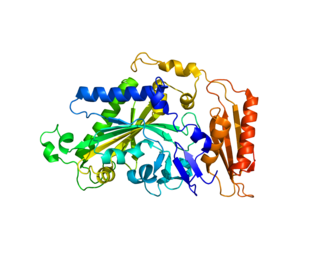
Probable G-protein coupled receptor 88 is a protein that in humans is encoded by the GPR88 gene.

The human gene SPAST codes for the microtubule-severing protein of the same name, commonly known as spastin.

Atlastin, or Atlastin-1, is a protein that in humans is encoded by the ATL1 gene.

116 kDa U5 small nuclear ribonucleoprotein component is a protein that in humans is encoded by the EFTUD2 gene.

Seipin is a protein that in humans is encoded by the BSCL2 gene.

Paraplegin is a protein that in humans is encoded by the SPG7 gene located on chromosome 16.

Ubiquitin-associated protein 1 is a protein that in humans is encoded by the UBAP1 gene.

pumilio RNA binding family member 3 is a protein that in humans is encoded by the PUM3 gene.

Receptor expression-enhancing protein 2 is a protein that in humans is encoded by the REEP2 gene.

Ankyrin repeat and FYVE domain-containing protein 1 is a protein that in humans is encoded by the ANKFY1 gene.

Methyltransferase-like protein 13 is an enzyme that in humans is encoded by the METTL13 gene.

G2/M phase-specific E3 ubiquitin-protein ligase is an enzyme that in humans is encoded by the G2E3 gene.

KIAA0196 is a human gene. The product is a protein that is a component of the WASH complex, which regulates actin assembly on intracellular vesicles. Mutations in KIAA0196 are implicated in some forms of hereditary spastic paraplegia.

Maspardin is a protein that in humans is encoded by the SPG21 gene.

Molybdenum cofactor sulfurase is an enzyme that in humans is encoded by the MOCOS gene.

KIAA1411, also known as KIAA1411, is a human gene. It has one paralog, FAM135B.

Phenylalanyl-tRNA synthetase, mitochondrial (FARS2) is an enzyme that in humans is encoded by the FARS2 gene. This protein encoded by FARS2 localizes to the mitochondrion and plays a role in mitochondrial protein translation. Mutations in this gene have been associated with combined oxidative phosphorylation deficiency 14, also known as Alpers encephalopathy, as well as spastic paraplegia 77 and infantile-onset epilepsy and cytochrome c oxidase deficiency.

Acetyl-coenzyme A transporter 1 also known as solute carrier family 33 member 1 (SLC33A1) is a protein that in humans is encoded by the SLC33A1 gene.

Zinc finger, FYVE domain containing 26 is a protein that in humans is encoded by the ZFYVE26 gene.
Spastic paraplegia 15 (SPG15) is a form of hereditary spastic paraplegia that commonly becomes apparent during childhood or adolescence. The disease is caused by mutations within the ZFYVE26 gene - also known as the SPG15 gene - and is passed down in an autosomal recessive manner.





















